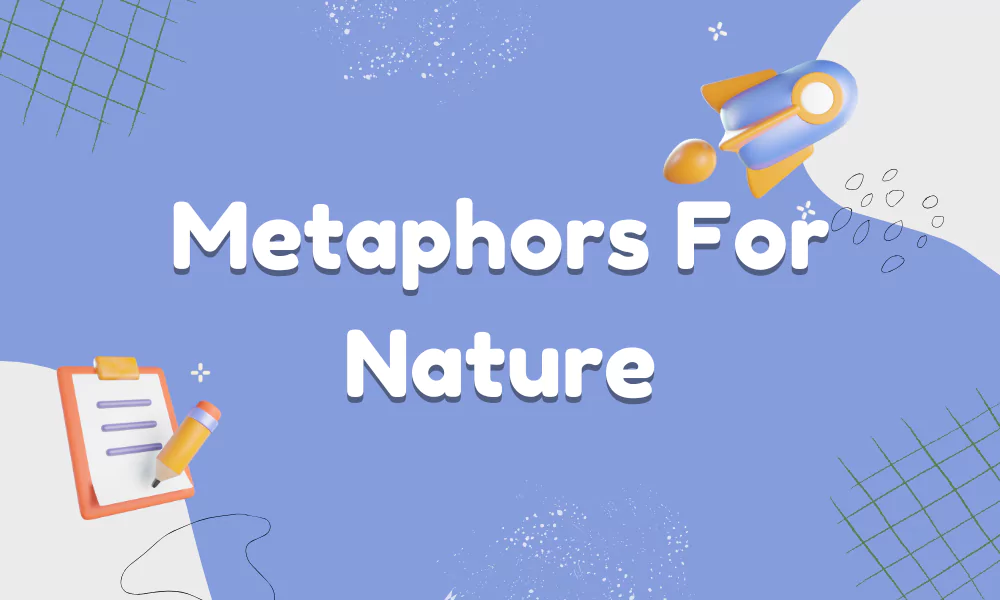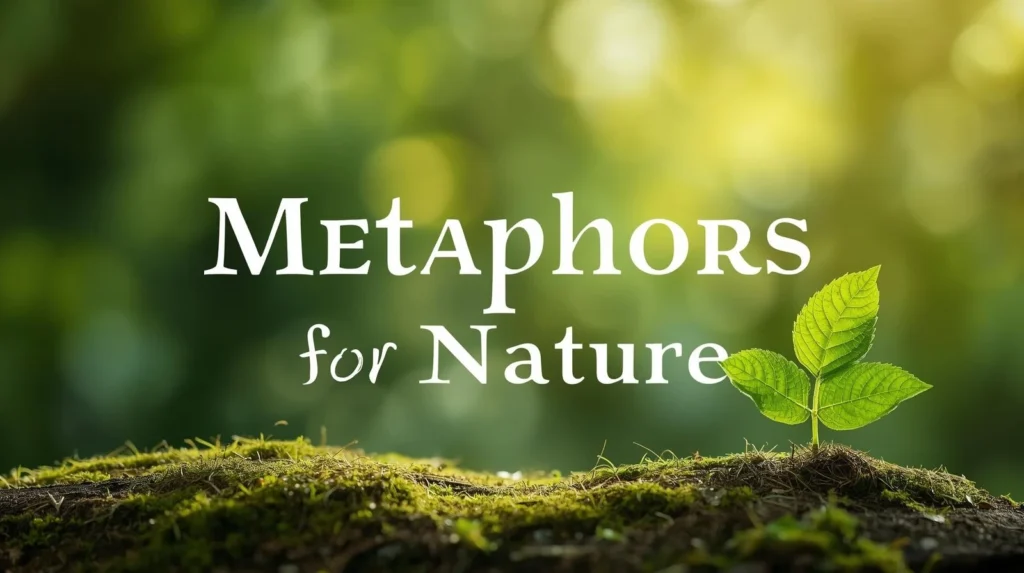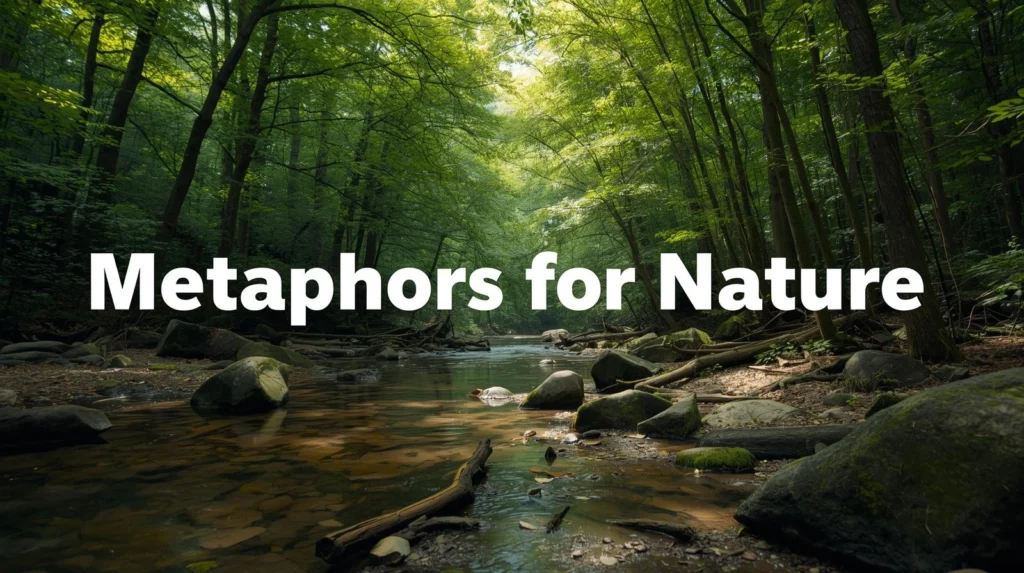Metaphors for Nature – Poetic Expressions of Earth’s Beauty and Life

Metaphors for nature allow us to see the world through fresh eyes, revealing connections between the natural world and human experience. Nature becomes a living poem, its rivers telling stories, its forests breathing with quiet wisdom, and its skies painting emotions beyond words. Through metaphor, we don’t just describe nature, we converse with it, finding reflections of life, resilience, and beauty in every leaf, wave, and gust of wind.
What Are Metaphors for Nature?
Nature metaphors are imaginative comparisons that help us understand and describe the natural world in deeper, more meaningful ways. Instead of stating facts, they express ideas by linking elements of nature to human emotions, experiences, or concepts. For example, calling the wind a whispering voice or the ocean a restless soul brings these natural elements to life and adds emotional depth to our perception of them. Such metaphors allow us to see nature not just as scenery, but as a living presence that reflects our thoughts, feelings, and journeys. They enrich language, inspire creativity, and remind us of the profound connection between humanity and the environment.

Everyday Metaphors for Nature
- The sun is a golden eye – Symbolizes watchfulness and life-giving energy.
Example: The golden eye of the sky opened over the hills. - The sky is a canvas – Represents nature’s ever-changing beauty.
Example: The sky was a canvas painted with hues of gold and crimson. - The wind is a whisper – Suggests mystery and unseen communication.
Example: The wind whispered secrets through the forest. - The river is a storyteller – Symbolizes time and continuity.
Example: The river told ancient tales as it flowed to the sea. - The forest has a heartbeat – Represents life, rhythm, and vitality.
Example: The forest’s heartbeat pulsed beneath the canopy. - The earth is a mother – Stands for nurturing and creation.
Example: Mother Earth cradles us in her arms of soil and sky. - The moon is a mirror – Reflects light, emotion, and introspection.
Example: The moon mirrored her calm and gentle thoughts. - The ocean is a soul – Symbolizes depth, emotion, and power.
Example: The ocean’s soul sighed beneath the waves. - The mountain is a teacher – Represents endurance and wisdom.
Example: Each climb taught him a lesson the mountain whispered in silence. - The rain is nature’s tears – Expresses sadness or cleansing.
Example: The sky wept softly as the rain began to fall. - The desert is a silent witness – Symbolizes timelessness and resilience.
Example: The desert watched centuries pass without a sound. - The dawn is a new beginning – Represents hope and renewal.
Example: Dawn broke, bringing with it a promise of change. - The stars are candles – Stand for guidance and light in darkness.
Example: The stars burned like candles in the vast night. - The breeze is a gentle hand – Symbolizes comfort and touch.
Example: The evening breeze brushed her face like a tender hand. - The storm is a roaring beast – Represents chaos and strength.
Example: The beast of thunder growled across the sky. - The tree is a guardian – Symbolizes protection and endurance.
Example: The ancient tree stood guard over the valley. - The garden is a sanctuary – A place of peace and harmony.
Example: Her garden was a sanctuary of quiet and color. - The cloud is a dream – Symbolizes imagination and transience.
Example: White dreams drifted lazily across the sky. - The leaf is a page – Represents stories of life and time.
Example: Each falling leaf turned a page of autumn’s tale. - The flame is life’s breath – Symbolizes vitality and energy.
Example: The campfire breathed warmth into the night. - The rainbow is a promise – Represents hope after hardship.
Example: A bright promise arched across the stormy sky. - The meadow is a quilt – Symbolizes harmony in diversity.
Example: The meadow stretched like a patchwork quilt of green and gold. - The earth is a living body – Represents the interconnectedness of all life.
Example: Rivers are her veins and forests her lungs. - The thunder is nature’s drum – Symbolizes power and rhythm.
Example: The sky beat its drum in warning. - The sun is a life-giver – Represents warmth and creation.
Example: The life-giver smiled upon the blooming fields. - The fog is a curtain – Suggests mystery and concealment.
Example: A gray curtain drifted across the sleeping valley. - The night is a blanket – Represents calm and rest.
Example: Darkness spread its soft blanket over the world. - The stars are eyes – Symbolize watchfulness or destiny.
Example: The eyes of heaven gazed upon the earth. - The ocean is a cradle – Represents origin and nurturing.
Example: Life rocked gently in the ocean’s cradle. - The fire is a wild spirit – Symbolizes freedom and passion.
Example: The wild spirit of the flames danced under the moon. - The valley is a cradle of peace – Represents serenity and refuge.
Example: They rested in the valley’s peaceful cradle. - The snow is a white blanket – Suggests purity and stillness.
Example: Winter laid its white blanket over the land. - The earth is a book – Symbolizes stories written in landscapes.
Example: Every mountain was a chapter of Earth’s history. - The wind is a traveler – Represents movement and change.
Example: The restless traveler roamed through the fields. - The sky is an ocean – Suggests vastness and freedom.
Example: The birds sailed across the ocean of blue above. - The stars are storytellers – Symbolize memory and myth.
Example: The stars told ancient stories to those who would listen. - The dawn is a painter – Represents new color and life.
Example: The dawn painted the world in amber and rose. - The soil is memory – Holds the past and nourishes the future.
Example: The soil remembered every root and footprint. - The seasons are chapters – Represent cycles of time and life.
Example: Autumn closed another chapter of the year’s story. - The river is life’s journey – Symbolizes change and progress.
Example: Her life flowed like a river; ever moving, always changing.
Cultural & Literary Metaphors for Nature
- Nature as a mirror of the soul – Reflects human emotions and states of mind.
Example: The calm lake mirrored his peaceful heart. - The Tree of Life – Symbol of growth, connection, and eternity.
Example: Every branch of the Tree of Life represents a story. - Nature as divine language – Seen as a reflection of spiritual truth.
Example: The forest spoke in God’s own language. - The Garden of Eden – Represents innocence, purity, and origin.
Example: The valley felt like a lost Eden untouched by time. - The Phoenix (fire and renewal) – Symbol of rebirth and transformation.
Example: The forest rose like a phoenix after the fire. - Nature as a teacher – Offers wisdom and moral lessons.
Example: The mountain taught her patience in silence. - The ocean as the subconscious – Represents mystery and emotional depth.
Example: He dived into the ocean of his own thoughts. - The moon as the feminine divine – Symbolizes intuition and cycles.
Example: She followed the moon’s rhythm to find balance. - The storm as fate or anger – Reflects emotional turmoil or divine power.
Example: The heavens raged as the hero faced his guilt. - The mountain has a spiritual ascent – Symbol of enlightenment or achievement.
Example: Each step toward the peak brought him closer to truth.
Read: Metaphors for Conflict
Creative & Modern Metaphors for Nature
- Nature as Wi-Fi for the soul – Represents reconnection and balance in a digital world. Example: A walk in the woods restored her better than any signal.
- The forest as Earth’s lungs – Highlights the role of trees in sustaining life.
Example: The forest’s breath kept the planet alive. - The ocean as a data stream – Symbolizes information and flow in the modern age. Example: The sea uploaded waves of memory to the shore.
- The sun as a charging station – Represents energy, renewal, and vitality.
Example: He stood in the sunlight, recharging his spirit. - The wind as invisible art – Suggests unseen forces shaping life.
Example: The wind sculpted clouds like a hidden artist. - Nature as Earth’s playlist – Represents the symphony of natural sounds.
Example: She listened to the playlist of rustling leaves and bird songs. - The night sky as a cosmic map – Symbolizes exploration and destiny.
Example: He traced his dreams across the galaxy’s map. - The desert as minimalist art – Reflects beauty in simplicity and silence.
Example: The desert was nature’s masterpiece of calm. - The mountain as a progress bar – Represents personal growth and achievement. Example: Each ridge climbed filled another bar of determination.
- Nature as a reset button – Symbolizes balance and renewal.
Example: Time in the wild pressed reset on her busy mind.

Synonyms of Nature
| Synonym | Meaning |
|---|---|
| The Natural World | Refers to everything that exists outside human creation, including plants, animals, and landscapes. |
| The Environment | The surroundings or conditions in which living beings exist and interact. |
| The Wilderness | Uncultivated or untamed areas of land that remain untouched by human influence. |
| The Ecosystem | The complex network of relationships among living organisms and their physical surroundings. |
| The Biosphere | The global sum of all ecosystems; the zone where life exists on Earth. |
| The Outdoors | Open natural spaces away from urban environments. |
| Mother Earth | A poetic and symbolic term for the planet as a nurturing, life-giving force. |
| The Living World | The collective life forms and systems that sustain existence. |
| Creation | Often used in a spiritual or poetic sense to describe the natural universe. |
| The Great Outdoors | A casual expression emphasizing the adventure and beauty of natural landscapes. |
How to Use Nature Metaphors in Writing & Speaking
- Connect Emotions to the Environment – Use elements of nature to express feelings. Example: Her anger was a storm breaking after years of silence.
- Show Growth and Change Through Natural Cycles – Compare personal development to seasons or natural processes.
Example: Like a tree in spring, he found new life after hardship. - Reflect Human Qualities in Nature – Give natural elements human traits to evoke empathy or wonder.
Example: The mountains stood proud, defying the storm. - Use Nature to Illustrate Abstract Ideas – Simplify complex emotions or concepts through tangible imagery.
Example: Hope is a seed that needs care to grow. - Blend Modern and Natural Imagery – Combine contemporary ideas with nature for fresh expression.
Example: Her thoughts streamed like rivers through a digital forest of ideas.
Read: Metaphors for Chocolate
Read: Metaphors for Hand
FAQs
Conclusion
Metaphors for nature remind us that the world around us is more than just scenery but a reflection of our emotions, growth, and existence. By comparing nature’s elements to human experiences, we bridge the gap between the physical and the spiritual, the seen and the felt. Whether it’s describing the sun as a guiding light or the river as life’s journey, these metaphors breathe life into our language and imagination. From everyday expressions to literary masterpieces, nature metaphors help us understand not only the environment but also ourselves.
